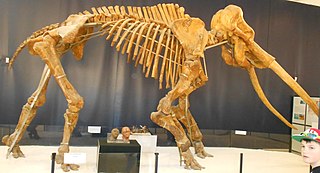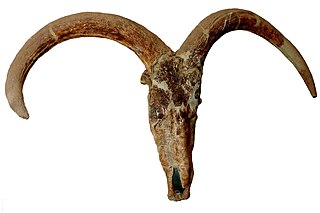The Holocene is the current geological epoch. It began approximately 9,700 years before the Common Era (BCE). It follows the Last Glacial Period, which concluded with the Holocene glacial retreat. The Holocene and the preceding Pleistocene together form the Quaternary period. The Holocene has been identified with the current warm period, known as MIS 1. It is considered by some to be an interglacial period within the Pleistocene Epoch, called the Flandrian interglacial.

Palaeoloxodon is an extinct genus of elephant. The genus originated in Africa during the Pliocene, and expanded into Eurasia during the Pleistocene. The genus contains some of the largest known species of elephants, over 4 metres (13 ft) tall at the shoulders, including the African Palaeoloxodon recki, the European straight-tusked elephant and the South Asian Palaeoloxodon namadicus. P. namadicus has been suggested to be the largest known land mammal by some authors based on extrapolation from fragmentary remains, though these estimates are highly speculative. In contrast, the genus also contains many species of dwarf elephants that evolved via insular dwarfism on islands in the Mediterranean, some only 1 metre (3.3 ft) in height, making them the smallest elephants known. The genus has a long and complex taxonomic history, and at various times, it has been considered to belong to Loxodonta or Elephas, but today is usually considered a valid and separate genus in its own right.

Stegodon is an extinct genus of proboscidean, related to elephants. It was originally assigned to the family Elephantidae along with modern elephants but is now placed in the extinct family Stegodontidae. Like elephants, Stegodon had teeth with plate-like lophs that are different from those of more primitive proboscideans like gomphotheres and mammutids. The oldest fossils of the genus are found in Late Miocene strata in Asia, likely originating from the more archaic Stegolophodon, shortly afterwards migrating into Africa. While the genus became extinct in Africa during the Pliocene, Stegodon remained widespread in South, Southeast and East Asia until the end of the Pleistocene.

The northern giraffe, also known as three-horned giraffe, is the type species of giraffe, G. camelopardalis, and is native to North Africa, although alternative taxonomic hypotheses have proposed the northern giraffe as a separate species.

During the Last Glacial Maximum, the mammoth steppe, also known as steppe-tundra, was once the Earth's most extensive biome. It stretched east-to-west, from the Iberian Peninsula in the west of Europe, across Eurasia to North America, through Beringia and Canada; from north-to-south, the steppe reached from the arctic islands southward to China. The mammoth steppe was cold and dry, and relatively featureless, though topography and geography varied considerably throughout. Some areas featured rivers which, through erosion, naturally created gorges, gulleys, or small glens. The continual glacial recession and advancement over millennia contributed more to the formation of larger valleys and different geographical features. Overall, however, the steppe is known to be flat and expansive grassland. The vegetation was dominated by palatable, high-productivity grasses, herbs and willow shrubs.
The Chibanian, widely known as the Middle Pleistocene, is an age in the international geologic timescale or a stage in chronostratigraphy, being a division of the Pleistocene Epoch within the ongoing Quaternary Period. The Chibanian name was officially ratified in January 2020. It is currently estimated to span the time between 0.770 Ma and 0.126 Ma, also expressed as 770–126 ka. It includes the transition in palaeoanthropology from the Lower to the Middle Paleolithic over 300 ka.

The European wild ass or hydruntine is an extinct equine from the Middle Pleistocene to Late Holocene of Europe and West Asia, and possibly North Africa. It is a member of the subgenus Asinus, and closely related to the living Asiatic wild ass. The specific epithet, hydruntinus, means from Otranto.

Pelorovis is an extinct genus of African wild cattle which existed during the Pleistocene epoch. The best known species is Pelorovis oldowayensis from Olduvai Gorge in Tanzania, from the Early Pleistocene. The species "Pelorovis" antiquus from the Late Pleistocene-Holocene has since been moved into Syncerus, the same genus as living African buffalo.

Asoriculus is an extinct genus of terrestrial shrews in the subfamily Soricinae and tribe Nectogalini, native to Europe and North Africa.

The latter half of the Late Pleistocene to the beginning of the Holocene saw extinctions of numerous predominantly megafaunal (large) animal species, which resulted in a collapse in faunal density and diversity across the globe. The extinctions during the Late Pleistocene are differentiated from previous extinctions by the widespread absence of ecological succession to replace these extinct megafaunal species, and the regime shift of previously established faunal relationships and habitats as a consequence. The timing and severity of the extinctions varied by region and are thought to have been driven by varying combinations of human and climatic factors. Human impact on megafauna populations is thought to have been driven by hunting ("overkill") as well as possibly environmental alteration. The relative importance of human vs climatic factors in the extinctions has been the subject of long-running controversy.

A gazelle is one of many antelope species in the genus Gazella. There are also seven species included in two further genera; Eudorcas and Nanger, which were formerly considered subgenera of Gazella. A third former subgenus, Procapra, includes three living species of Asian gazelles.

Chelonoidis is a genus of turtles in the tortoise family erected by Leopold Fitzinger in 1835. They are found in South America and the Galápagos Islands, and formerly had a wide distribution in the West Indies.

Loxodonta atlantica is an extinct African species of elephant in the genus Loxodonta. It was larger than modern African elephants, with more progressive dentition. It includes Pleistocene fossils from Ternifine, Algeria Middle Pleistocene fossils from Elandsfontein, South Africa and Late Pliocene fossils from the Omo River, Ethiopia It is suggested to have an extinction date of around 400,000 years ago, during the Middle Pleistocene. L. atlantica has been suggested to have probably derived from L. adaurora; or L. exoptata. It is likely ancestral to the living African bush elephant, L. africana, which it coexisted with during the Middle Pleistocene prior to its extinction. The species is divided into two subspecies: L. atlantica atlantica and L. atlantica zulu. The type for Loxodonta atlantica is housed in the Muséum national d'histoire naturelle in Paris, but is listed without a specimen number.

Syncerus antiquus is an extinct species of buffalo from the Late Pleistocene and Holocene of Africa. It was one of the largest species in its family, potentially weighing up to 2,000 kilograms (4,400 lb). Due to this fact, it is sometimes known as the African giant buffalo. The time of its extinction is of debate; Syncerus antiquus either became extinct at the end of the Late Pleistocene about 12,000 years ago or during the Holocene, some 4,000 years ago.

Dusicyon avus is an extinct species of cerdocyonine canid in the genus Dusicyon, native to South America during the Pleistocene and Holocene epochs. It was medium to large, about the size of a German shepherd. It was closely related to the Falkland Islands wolf (Dusicyon australis), which descended from a population of D. avus. It appears to have survived until very recently, perhaps 400 years ago.

Megaceroides algericus is an extinct species of deer known from the Late Pleistocene to the Holocene of North Africa. It is one of only two species of deer known to have been native to the African continent, alongside the Barbary stag, a subspecies of red deer. It is considered to be closely related to the giant deer species of Eurasia.
Antidorcas bondi, or Bond's springbok, is an extinct species of antelope whose fossils have been found in Zimbabwe and South Africa.
Antidorcas australis, also known as the southern springbok, is an extinct species of antelope from the Pleistocene and Holocene of South Africa. It is a close relative of the living springbok.
Gazella tingitana is an extinct species of gazelle from the Late Pleistocene of Morocco.













